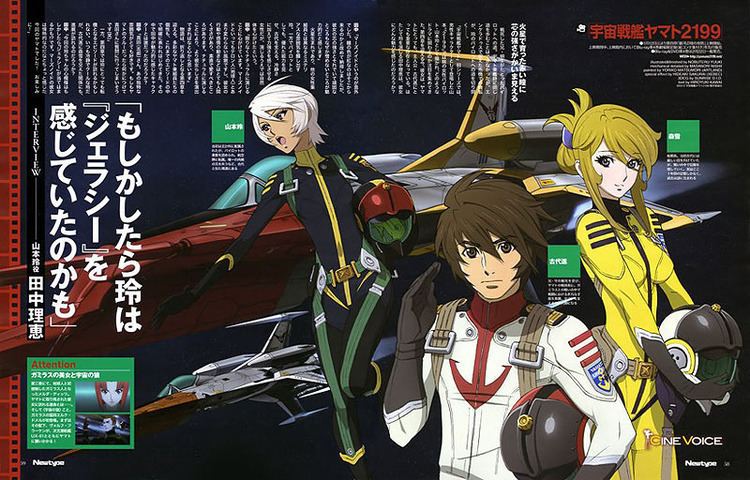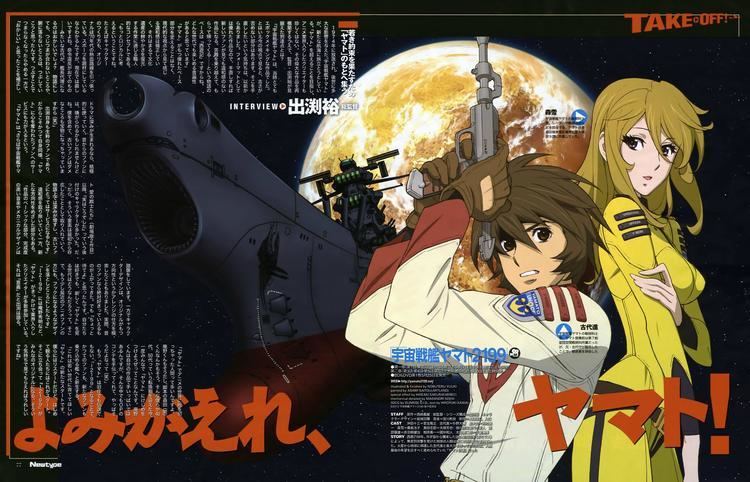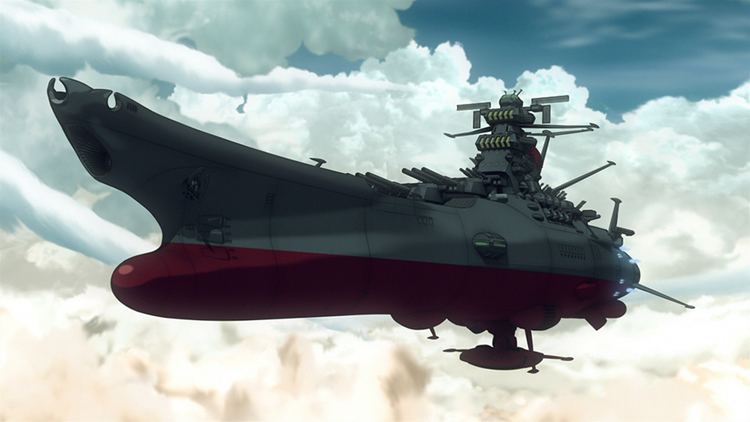Space Battleship Yamato 2199
8 /10 1 Votes
Country Japan | Director Yutaka Izubuchi Language Japanese | |||||||||||||||||||||||||||||||||
Release date October 11, 2014 (2014-10-11) | ||||||||||||||||||||||||||||||||||
Space battleship yamato 2199 2012 new trailer
Space Battleship Yamato 2199 (宇宙戦艦ヤマト2199, Uchū Senkan Yamato Ni-ichi-kyū-kyū) is a 2012 Japanese military science fiction anime television series that is a remake of the first Space Battleship Yamato television series created by Yoshinobu Nishizaki and Leiji Matsumoto in 1974, known in the United States as Star Blazers. The series is a space opera, and was originally screened back-to-back in theaters across Japan, a few episodes at a time prior to release on home video, and aired on television from April 7, 2013 to September 29, 2013.
Contents
- Space battleship yamato 2199 2012 new trailer
- Space battleship yamato 2199 anime review animeeveryday anime reviews
- Plot
- Cast
- Production
- Release
- Compilation film
- Toysmodels
- Differences from the original series
- Reception
- References

Two movies based on the series were released in 2014. A sequel series, titled Space Battleship Yamato 2202: Warriors of Love is currently in production.

Space battleship yamato 2199 anime review animeeveryday anime reviews
Plot

In 2191, Earth made first contact with aliens called Gamilas. First attempt at peaceful contact with the Gamilas failed, resulting in interstellar war. The United Nations Cosmo Navy, even though outmatched by the Gamilas space naval forces, was able to stop their direct assaults on Earth in the second battle for Mars, but suffered heavy losses in the process. The Gamilas, from their military base on Pluto, then started planetary bombardment with modified asteroids called planet bombs. The planet bombs hampered United Nations efforts to rebuild their space fleet and forced Earth to build underground cities to protect humanity. The planet bombs altered the atmosphere and irradiated the planetary surface, causing the complete destruction of the planet's biosphere. The Gamilas then started what is believed to be their first step in terraforming ―preparing the Earth to be inhabited by themselves― by introducing plant life that was lethal to any life on Earth. With mankind facing extinction, the United Nations started planning for a small colony of humans to leave Earth in an attempt at the survival of humanity, called the Isumo Plan. But in early 2198 Starsha, from the planet Iscandar, learned of Earth's situation and dispatched her sister Yurisha to Earth. Yurisha brought with her the designs to what is called the Dimensional Wave Motion Engine, providing for interstellar flight along with other technological assistance to Earth. The Iscandarans revealed that they could reverse the damage done to the Earth with the Cosmo Reverse System. For technical reasons they could not send the system directly and would need Earth to send a ship for it. The United Nations then scrapped the Isumo Plan in order to build a new Cosmo Navy ship to retrieve the Cosmo Reverse System. The new ship was designed as a heavily-armed space battleship. To conceal the ship's construction from the Gamilas, Earth built the new ship at the same site as the sunken World War II Yamato battleship. The new space battleship was also named the Yamato for which the series Space Battleship Yamato 2199 is named.

Over the course of the series, the Yamato and its crew were continually attacked by Gamilan forces on Jupiter, the moons of Saturn, and Pluto. As the Yamato battled its way out of the Solar System and the Milky Way Galaxy, Gamilas leader Abert Dessler took a personal interest in the unusually-advanced and seemingly-unstoppable Earth vessel. Suspicious of Iscandar's involvement in the humans' quest, Dessler schemed to stop the Yamato at all costs before it could fulfill its mission ― even as political intrigue plagued his empire. To this end, he ordered his top military commanders and most sophisticated spacecraft into the fight, putting the determination of the Yamato crew to even more rigorous tests as they coped with questions about their mission and strange incidents aboard their own ship.
Cast

Production
The new series is a remake of the original Space Battleship Yamato television series from 1974, with some changes in the main story, new characters (including several female ones), a more modern tech design, and an animation style inspired by that of the original series. The original intro music theme from the first series composed by Hiroshi Miyagawa with vocals by Isao Sasaki has also been re-scored for this new production by Hiroshi's son Akira.

Yutaka Izubuchi serves as supervising director, with character designs by Nobuteru Yuki, and Junichiro Tamamori and Makoto Kobayashi in charge of mecha and conceptual designs. The series is animated by Xebec (episodes 1–10 were co-produced with AIC). Famous anime director and creator Hideaki Anno designed the new series' opening sequence, which is a homage to the one that appeared in the first television series.
The full anime series started airing on April 7, 2013, in the MBS/TBS's 5:00 p.m timeslot, replacing Magi: The Labyrinth of Magic.
The Yamato wreck in the 1974 series where the Space Battleship Yamato was built under was based on the general assumption in the 1970s that the warship sank intact. When the actual wreck was found in 1985, it was in a much more mangled shape than previously thought. In an April 2013 interview with Japanese online hobby shop Ami Ami, Bandai model developer Hirofumi Kishiyama said the emergence of the space battleship itself in 2199 was a plot device that needed to be resolved. Taking into account the 1985 discovery, he said the new Yamato "wreck" is simply camouflage for the warship being built underneath. Where the 1974 space battleship Yamato was conceptualized to be the same length as the original battleship at 263 meters, the spaceship in the new series was enlarged to 333m to address design discrepancies found in the first show.
Characters who appeared in the original series' second and third seasons are included in 2199 as well.
The first episode of the show has been dubbed into English by Bang Zoom! Entertainment, and was shown at both Anime Expo and San Diego Comic-Con in the Summer of 2013.
In 2014, a feature-length compilation of the Space Battleship Yamato 2199 series titled Space Battleship Yamato 2199: A Voyage to Remember and an original movie based on the series, Space Battleship Yamato 2199: Odyssey of the Celestial Ark, were released.
Release
Episode 1 of the series was previewed on April 6, 2012 on Family Gekijo channel, although the remaining 25-minute episodes did not run on television until 2013.
Episodes 1 and 2 of the new series were released as a fifty-minute anime film called Dai-Isshō Harukanaru Tabidachi (Chapter 1: "The Long Journey") premiering in Japanese cinemas on April 7, 2012 (the sixty-seventh anniversary of the loss of the Yamato during the Battle of Okinawa). It was also released on May 25, 2012 as Blu-ray and DVD format volumes in Japan. Six more anime films which will be one hundred-plus minute compilations, containing four episodes each, for a total of twenty-six, will be released every few months in select theaters across Japan through 2013. The series commenced weekly broadcast on April 7, 2013.
The second film, Dai-nishō: Taiyōken no Shitō (Chapter 2: "Desperate Struggle in the Heliosphere"), featured episodes 3-6. It opened in ten theaters in Japan on June 30, 2012. The Blu-ray Disc and DVD volumes were released on July 27, 2012.
The third film, Dai-sanshō: Hateshinaki Kōkai (Chapter 3: "The Endless Voyage"), featuring Episodes 7-10, opened in twelve Japanese theaters from October 13 through October 26, 2012 (expanding from ten theaters for the previous films). The Blu-ray and DVD volumes were released on November 22, 2012.
The fourth film, Dai-yonshō: Ginga Henkyō no Kōbō (Chapter 4: "Defense of the Galactic March"), featured Episodes 11-14, and opened in twelve Japanese theaters from January 12 through January 26, 2013. The Blu-ray and DVD volumes were released on February 22, 2013.
The fifth film, Dai-goshō: Bōkyō no Gingakan Kukan (Chapter 5: "The Redolence of Intergalactic Space") featuring Episodes 15-18, was released in twelve Japanese theaters on April 13, 2013. The Blu-ray and DVD volumes were released on May 28, 2013.
The sixth film, Dai-rokushō: Tōtatsu! Dai Magellan (Chapter 6: "Arrival! Large Magellanic Cloud") featuring episodes 19-22 was released in sixteen Japanese theaters on June 15, 2013. The Blu-ray and DVD volumes were released on July 26, 2013.
The seventh and final film, Dai-nanashō: Soshite Kan wa Iku (Chapter 7: "And Now the Warship Comes") featuring episodes 23-26 was released in Japanese theaters on August 24, 2013. Unlike the previous episodes (other than the first one), they first aired on TV before the Blu-ray and DVD volumes were released on October 25, 2013.
Compilation film
Space Battleship Yamato 2199: A Voyage to Remember (宇宙戦艦ヤマト2199 追憶の航海, Uchū Senkan Yamato 2199: Tsuioku No Koukai), also known as Space Battleship Yamato 2199: Voyage of Remembrance, is a 2014 Japanese anime recap film that compiles the twenty-six episodes of the Space Battleship Yamato 2199 anime series. Writers have unofficially used the English translations Space Battleship Yamato 2199: Voyage of Remembrance and Space Battleship Yamato 2199: A Voyage to Remember. However, the distributor has yet to choose an official English language title.
Toys/models
Bandai started releasing kits based on the vehicles seen in the series in 2012.
As of January 2015, the company produced 1/1000 scale models of the Yamato, two sets of UNCN warships, four sets of Garmilas warships, the Gamilas Polmeria-class Assault Carrier, the Gelvades-class Assault Carrier "Darold," and the Guipellon-class multi-deck carriers Lambea, Balgray, and the Schderg. Some of these kits also contain bonus kits, including reissues of certain warship kits from the original series' Mecha Collection line. The line Garmillas warships are also available as online-exclusive Imperial Guard sets, sporting green blue colors. Test shots of a 1/1000 version of the Zelguud-class dreadnought Domelus III and the Deusula II dreadnought were made public in 2013. Bandai originally held back on a full release for the Domelus III, stating that the model's size - around two feet long - was too big for the average Japanese home. The 1/500 release of the Yamato, measuring at over two feet, two inches - eventually prompted the release. The Gatlantis Empire's ships also appeared in the main kit line and the Mecha Collection line in 2014.
Vehicles from the series are available in 1/72 scale. The line started with the α-1 and α-2 Cosmo Zeroes in 2012. The March 2013 issue of Dengeki Hobby magazine had a free 1/72 Cosmo Falcon fighter packaged and Bandai followed suit with recast of the Cosmo Falcon (in Saburo Kato and Akira Yamamoto's paint schemes) later in 2013. Some of the 1/1000 kits also have their own space fighter models, with the Polmeria including a free DWG229 Melanka flying-wing bomber, two FG14 Zedora fighters with the Balgray, a DWG262 Czvarke fighter with Garmillas Warship set III and the FG156 Sumaruhi recon plane with Garmillas Warship Set IV.
Taking off from previous efforts to produce specific paint sets for Gundam HGUC models, Gunze Sangyo is also producing special paint sets for the 2199 warship kits.
On January 2014, Bandai also released a Yamato 2199 version of the Battleship Yamato (number GX-64) in their Soul of Chogokin line of adult collector's toys, which is a total redesign from their previous release (number GX-57.)
Differences from the original series
The series is markedly different from the original in many ways. Those include:
Reception
Kotaku reviewer Richard Eisenbeis gave the film, A Voyage to Remember, an unequivocally negative judgment. In his review, Eisenbeis noted that unlike many other recap anime movies, A Voyage to Remember added virtually no meaningful new content to the Yamato 2199 story. He went on to point out that the twenty-six episodes of the series had already been shown in cinemas and therefore did not benefit from an additional big screen showing, and with nine and a half hours of original story cut to two and a half for the recap film, backstory and character development were almost completely sacrificed.
